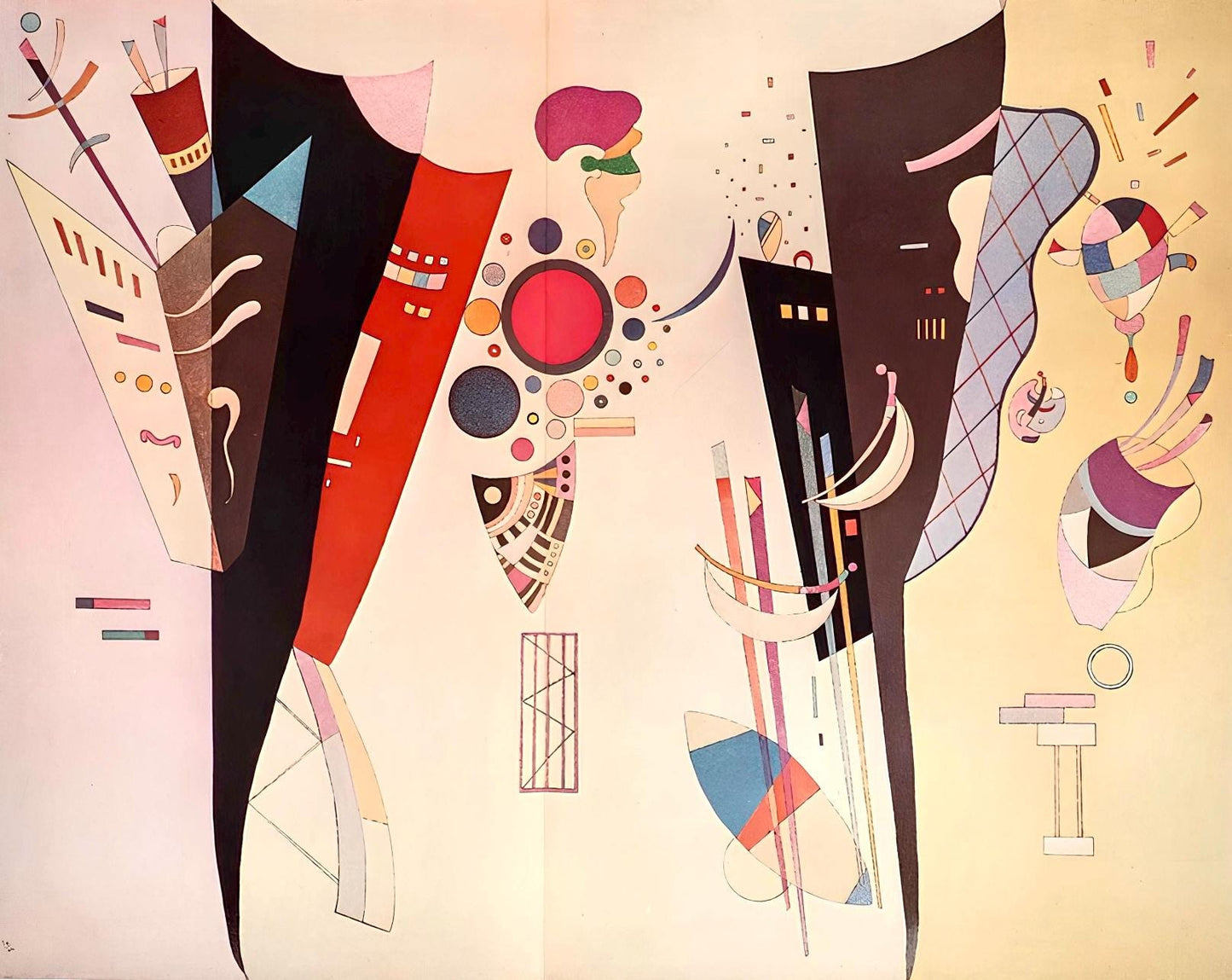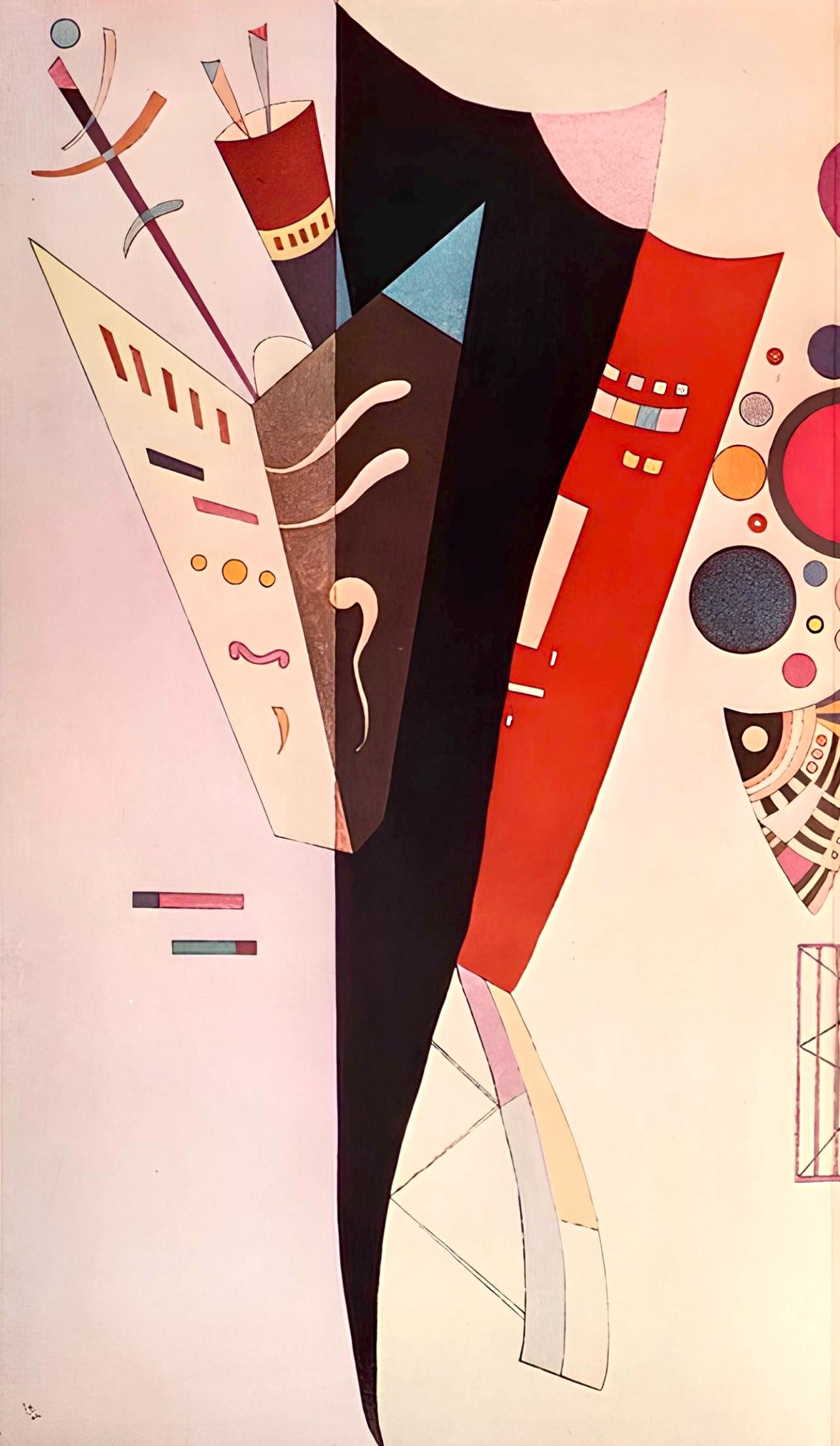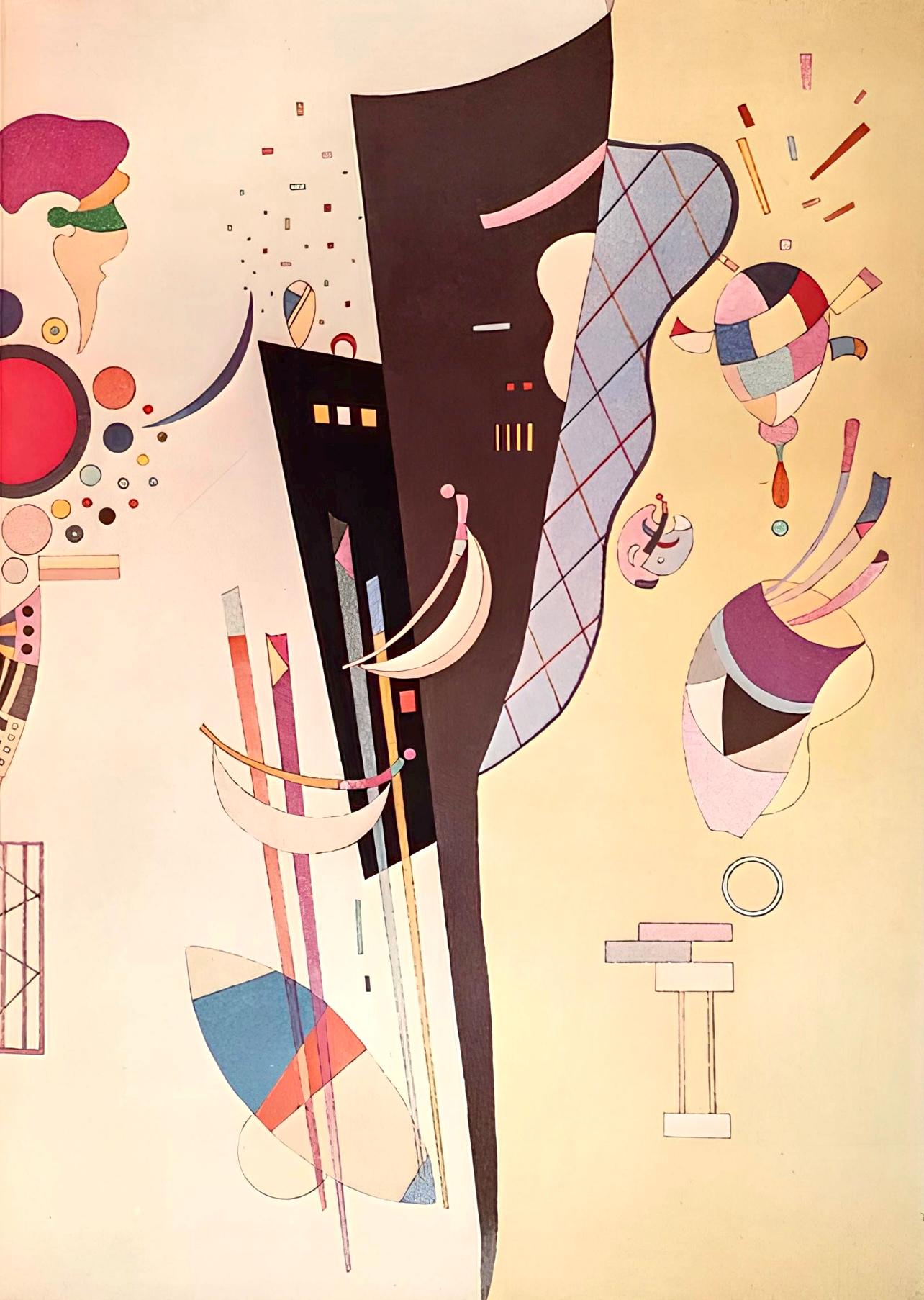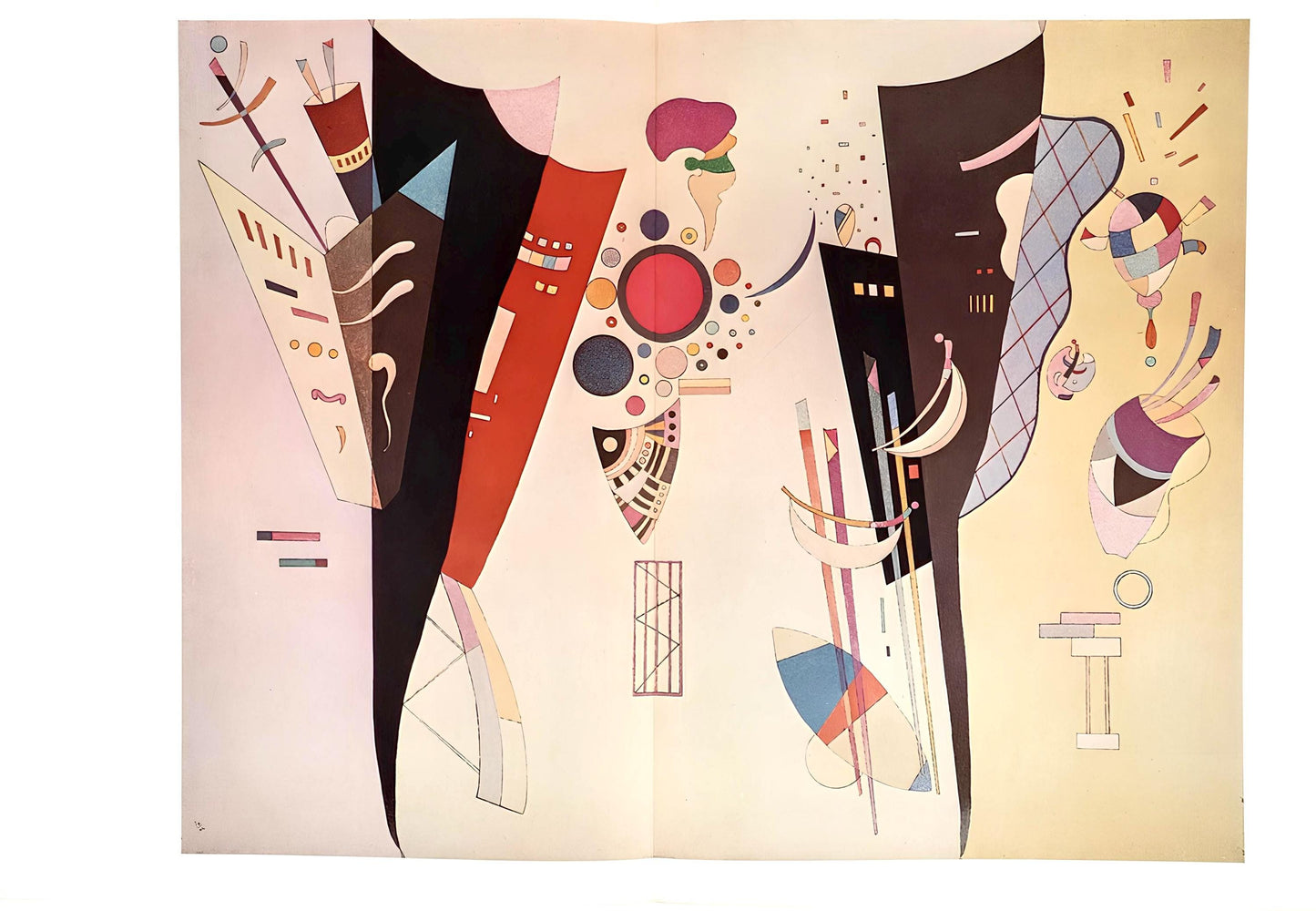1
/
of
4
Auction Ended: August 12, 2025
Post-Auction Sale Ends in:
Wassily Kandinsky, Composition, Derrire Le Miroir, Lithograph
Wassily Kandinsky, Composition, Derrire Le Miroir, Lithograph
Regular price
$1,026.30 USD
Regular price
$0.00 USD
Sale price
$1,026.30 USD
Unit price
/
per
Couldn't load pickup availability
Condition: Pre-Owned
Lithograph on vlin paper. Paper size: 15 x 22 inches. Excellent condition, with centerfold, as issued. Inscription: Unsigned and unnumbered, as issued. Notes: From Derrire le miroir, N 179, 1969. Published by Aim Maeght, diteur, Paris; printed by ditions Pierre Feu, Galerie Maeght, Paris. Excerpted from the folio (translated from French), This issue of "'Behind the Mirror" includes a luxury edition printed on vlin de Lana and limited to 150 numbered examples. Excerpte......
Lithograph on vlin paper. Paper size: 15 x 22 inches. Excellent condition, with centerfold, as issued. Inscription: Unsigned and unnumbered, as issued. Notes: From Derrire le miroir, N 179, 1969. Published by Aim Maeght, diteur, Paris; printed by ditions Pierre Feu, Galerie Maeght, Paris. Excerpted from the folio (translated from French), This issue of "'Behind the Mirror" includes a luxury edition printed on vlin de Lana and limited to 150 numbered examples. Excerpte......
Condition: Pre-Owned
Lithograph on vlin paper. Paper size: 15 x 22 inches. Excellent condition, with centerfold, as issued. Inscription: Unsigned and unnumbered, as issued. Notes: From Derrire le miroir, N 179, 1969. Published by Aim Maeght, diteur, Paris; printed by ditions Pierre Feu, Galerie Maeght, Paris. Excerpted from the folio (translated from French), This issue of "'Behind the Mirror" includes a luxury edition printed on vlin de Lana and limited to 150 numbered examples. Excerpted from a Christies, New York lot essay, The life span of Derrire le Miroir was thirty-five years. Publication began in 1946. Aim Maeght, initiator of Derrire le Miroir, had already made few attempts to start publications illustrated with fine printed lithographs in colours in the years prior to the launch of Derrire le Miroir. The name, Derrire le Miroir was suggested by Jacques Kober, manager of Galerie Maeght. The gallery had opened in 1945; the first number of Derrire le Miroir was released a year later. For this first issue Geer van Velde was invited to create lithographs to illustrate the publication. The lithographs in the first issue was printed by Mourlot, Paris. The first three issues of Derrire le Miroir were unsuccessful for Maeght as far as the edition sizethe initial print-runs were far too large. From 30,000 for the first issue, the number was taken down to 10,000 for numbers two and three, until Derrire le Miroir number four was published in an edition of 1500. Maeght instituted a policy whereby unsold issues were recycled and used for the fabrication of new paper for the coming editionsthis served to both conserve resources and also usually result in ultimate edition sizes far less than 1,500. With number four, the permanent format for Derrire le Miroir was established. Lithographs in colours were key; text was limited to comments on the featuring artist's exhibition taking place in the Galerie Maeght, and this catalogue format was defining to Derrire le Miroir. Galerie Maeght took on the leading role in Paris and presented all main artists including Braque, Matisse, Chagall, Lger, Bonnard, Chillida and many more. So too did Derrire le Miroir. The idea of a magazine was meanwhile still on the mind of Aim Maeght. He found an insert as a solution. Two, and later four, pages of art review were inserted from 1952 onwards. In 1968 this find had ripened to independency and the dream of Aim Maeght was now a tangible fact named l'Art vivant. Derrire le Miroir was on it's own again. Over 250 issues in a row. At that point publisher Aim Maeght wished to make a mark with the publication of an hommage to all who once contributed to the magazine which came in the form of issue number 250, but was delayed by the death of Aim Maeght. It was published after number 253 in 1982 and became a tribute to Aim and Margurite Maeght and 35 years of friendship with artists and poets. The era of Derrire le Miroir was closed with that final publication.
WASSILY KANDINSKY (1866-1944) was a Russian painter and art theorist. Kandinsky is generally credited as one of the pioneers of abstraction in western art and in influence to the Modern masters including, Picasso. Born in Moscow, he spent his childhood in Odessa, Ukraine, where he graduated from Odessa Art School. He enrolled at the University of Moscow, studying law and economics. Successful in his profession, he was offered a professorship (chair of Roman Law) at the University of Dorpat (today Tartu, Estonia). Kandinsky began painting studies (life-drawing, sketching and anatomy) at the age of 30. In 1896 Kandinsky settled in Munich, studying first at Anton Abe's private school and then at the Academy of Fine Arts. He returned to Moscow in 1914, after the outbreak of World War I. Following the Russian Revolution, Kandinsky "became an insider in the cultural administration of Anatoly Lunacharsky," and helped establish the Museum of the Culture of Painting. However, by then "his spiritual outlook... was foreign to the argumentative materialism of Soviet society", and opportunities beckoned in Germany, to which he returned in 1920. There he taught at the Bauhaus school of art and architecture from 1922 until the Nazis closed it in 1933. He then moved to France, where he lived for the rest of his life, becoming a French citizen in 1939 and producing some of his most prominent art. He died in Neuilly-sur-Seine in 1944, three days before his 78th birthday.
Product Disclaimer: Please review the full description and photos. Lithographs may be plate-signed, hand-signed, or slab-signed and can include a COA (see images); edition numbers shown may vary from the one shipped. Pricing reflects signature type—hand-signed pieces carry a premium and are clearly labeled. 'After' or 'nach' indicates an authorised lithographic reproduction in the style of the named artist, not a unique original. For inquiries, please reach out to support@seuyco.com. By registering for or placing a bid in any SEUYCO auction, you confirm that you have read, understood, and agree to our Shipping, Payment, and Auction Policies.
Lithograph on vlin paper. Paper size: 15 x 22 inches. Excellent condition, with centerfold, as issued. Inscription: Unsigned and unnumbered, as issued. Notes: From Derrire le miroir, N 179, 1969. Published by Aim Maeght, diteur, Paris; printed by ditions Pierre Feu, Galerie Maeght, Paris. Excerpted from the folio (translated from French), This issue of "'Behind the Mirror" includes a luxury edition printed on vlin de Lana and limited to 150 numbered examples. Excerpted from a Christies, New York lot essay, The life span of Derrire le Miroir was thirty-five years. Publication began in 1946. Aim Maeght, initiator of Derrire le Miroir, had already made few attempts to start publications illustrated with fine printed lithographs in colours in the years prior to the launch of Derrire le Miroir. The name, Derrire le Miroir was suggested by Jacques Kober, manager of Galerie Maeght. The gallery had opened in 1945; the first number of Derrire le Miroir was released a year later. For this first issue Geer van Velde was invited to create lithographs to illustrate the publication. The lithographs in the first issue was printed by Mourlot, Paris. The first three issues of Derrire le Miroir were unsuccessful for Maeght as far as the edition sizethe initial print-runs were far too large. From 30,000 for the first issue, the number was taken down to 10,000 for numbers two and three, until Derrire le Miroir number four was published in an edition of 1500. Maeght instituted a policy whereby unsold issues were recycled and used for the fabrication of new paper for the coming editionsthis served to both conserve resources and also usually result in ultimate edition sizes far less than 1,500. With number four, the permanent format for Derrire le Miroir was established. Lithographs in colours were key; text was limited to comments on the featuring artist's exhibition taking place in the Galerie Maeght, and this catalogue format was defining to Derrire le Miroir. Galerie Maeght took on the leading role in Paris and presented all main artists including Braque, Matisse, Chagall, Lger, Bonnard, Chillida and many more. So too did Derrire le Miroir. The idea of a magazine was meanwhile still on the mind of Aim Maeght. He found an insert as a solution. Two, and later four, pages of art review were inserted from 1952 onwards. In 1968 this find had ripened to independency and the dream of Aim Maeght was now a tangible fact named l'Art vivant. Derrire le Miroir was on it's own again. Over 250 issues in a row. At that point publisher Aim Maeght wished to make a mark with the publication of an hommage to all who once contributed to the magazine which came in the form of issue number 250, but was delayed by the death of Aim Maeght. It was published after number 253 in 1982 and became a tribute to Aim and Margurite Maeght and 35 years of friendship with artists and poets. The era of Derrire le Miroir was closed with that final publication.
WASSILY KANDINSKY (1866-1944) was a Russian painter and art theorist. Kandinsky is generally credited as one of the pioneers of abstraction in western art and in influence to the Modern masters including, Picasso. Born in Moscow, he spent his childhood in Odessa, Ukraine, where he graduated from Odessa Art School. He enrolled at the University of Moscow, studying law and economics. Successful in his profession, he was offered a professorship (chair of Roman Law) at the University of Dorpat (today Tartu, Estonia). Kandinsky began painting studies (life-drawing, sketching and anatomy) at the age of 30. In 1896 Kandinsky settled in Munich, studying first at Anton Abe's private school and then at the Academy of Fine Arts. He returned to Moscow in 1914, after the outbreak of World War I. Following the Russian Revolution, Kandinsky "became an insider in the cultural administration of Anatoly Lunacharsky," and helped establish the Museum of the Culture of Painting. However, by then "his spiritual outlook... was foreign to the argumentative materialism of Soviet society", and opportunities beckoned in Germany, to which he returned in 1920. There he taught at the Bauhaus school of art and architecture from 1922 until the Nazis closed it in 1933. He then moved to France, where he lived for the rest of his life, becoming a French citizen in 1939 and producing some of his most prominent art. He died in Neuilly-sur-Seine in 1944, three days before his 78th birthday.
Product Disclaimer: Please review the full description and photos. Lithographs may be plate-signed, hand-signed, or slab-signed and can include a COA (see images); edition numbers shown may vary from the one shipped. Pricing reflects signature type—hand-signed pieces carry a premium and are clearly labeled. 'After' or 'nach' indicates an authorised lithographic reproduction in the style of the named artist, not a unique original. For inquiries, please reach out to support@seuyco.com. By registering for or placing a bid in any SEUYCO auction, you confirm that you have read, understood, and agree to our Shipping, Payment, and Auction Policies.
+ Read More









